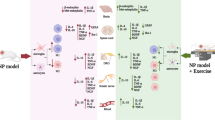Nuclear factor kappa B (NF-κB) is a transcription factor that regulates the expression of a large set of genes involved in immune and inflammatory processes. It has been suggested that the release of specific cytokines following nerve damage has a stimulatory action, activating NF-κB in neurons in the spinal ganglia (SG), which may have protective influences on sensory neurons. However, the complexity of this factor has led to contradictory conclusions on the role of NF-κB in damaged SG neurons. The aim of the present work was to determine whether NF-κB is activated in sensory neurons in mature SG in conditions of peripheral nerve damage using transgenic reporter mice in which activation of NF-κB leads to expression of the lac-z reporter gene. These experiments showed that expression of β-galactosidase (β-gal) did not occur either in damaged SG neurons or in neurons on the contralateral side. However, powerful β-gal expression was seen in damaged muscle tissue. This may reflect the regressive influence of additional signal molecules on NF-κB activity in sensory neurons.
Similar content being viewed by others
References
Yu. A. Chelyshev, “Factors maintaining the regeneration of peripheral nerve conductors,” Usp. Fiziol. Nauk., 26, No. 2, 57–77 (1995).
B. P. Ashburner, S. D. Westerheide, and A. S. Baldwin, Jr., “The p65 (RelA) subunit of NF-kappaB interacts with the histone deacetylase (HDAC) corepressors HDAC1 and HDAC2 to negatively regulate gene expression,” Mol. Cell. Biol., 21, No. 20, 7065–7077 (2001).
A. S. Baldwin, Jr., “The NF-kappa B and I kappa B proteins: new discoveries and insights,” Annu. Rev. Immunol., No. 14, 649–683 (1996).
A. L. Bhakar, L. L. Tannis, C. Zeindler, et al., “Constitutive nuclear factor-kappa B activity is required for central neuron survival,” J. Neurosci., 22, No. 19, 8466–8475 (2002).
H. Carlsen, J. O. Moskaug, S. H. Fromm, et al., “In vivo imaging of NF-kappa B activity,” J. Immunol., 168, No. 3, 1441–1446 (2002).
J. J. Inglis, A. Nissim, D. M. Lees, et al., “The differential contribution of tumour necrosis factor to thermal and mechanical hyperalgesia during chronic inflammation,” Arthritis Res. Ther., 7, No. 4, 807–816 (2005).
W. Ma and M. A. Bisby, “Increased activation of nuclear factor kappa B in rat lumbar dorsal root ganglion neurons following partial sciatic nerve injuries,” Brain Res., 797, No. 2, 243–254 (1998).
S. Mehmet, “NF-kappaB functions in the nervous system: from development to disease,” Biochem. Pharmacol., 72, No. 9, 1180–1195 (2006).
P. G. Murphy, L. S. Borthwick, R. A. Johnston, et al., “Nature of the retrograde signal from injured nerves that induces interleukin-6 mRNA in neurons,” J. Neurosci., 19, No. 10, 3791–3800 (1999).
H. L. Pahl, “Activators and target genes of Rel/NF-kappaB transcription factors,” Oncogene, 18, No. 49, 6853–6866 (1999).
G. Pollock, K. R. Pennypacker, S. Memet, et al., “Activation of NF-kappaB in the mouse spinal cord following sciatic nerve transection,” Exp. Brain Res., 165, No. 4, 470–477 (2005).
G. Raivich and M. Makwana, “The making of successful axonal regeneration: genes, molecules and signal transduction pathways,” Brain Res. Rev., 53, No. 2, 287–311 (2007).
R. N. Saha, M. Jana, K. Pahan, et al., “MAPK p38 regulates transcriptional activity of NF-kappaB in primary human astrocytes via acetylation of p65,” J. Immunol., 179, No. 10, 7101–7109 (2007).
R. Schmidt-Ullrich, S. Memet, A. Lilienbaum, et al., “NF-kappaB activity in transgenic mice: developmental regulation and tissue specificity,” Development, 122, No. 7, 2117–2128 (1996).
Author information
Authors and Affiliations
Corresponding author
Additional information
Translated from Morfologiya, Vol. 137, No. 2, pp. 18–22, March–April, 2010.
Rights and permissions
About this article
Cite this article
Gushchina, S.V., Volkova, O.V., Kruglyakov, P.P. et al. Transcriptional Activity of Nuclear Factor Kappa B (NF-κB) in Post-Traumatic Sensory Neurons (a histochemical study). Neurosci Behav Physi 41, 228–232 (2011). https://doi.org/10.1007/s11055-011-9404-y
Received:
Revised:
Published:
Issue Date:
DOI: https://doi.org/10.1007/s11055-011-9404-y




